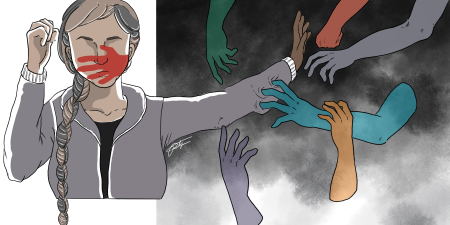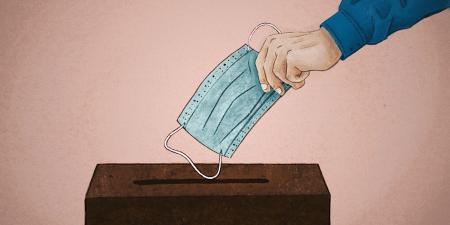Abstract
Many health professions education institutions exist on land once inhabited by American Indians and Alaska Natives (AI/AN). Land acknowledgment by these academic organizations is helpful, but collaborative support of AI/AN health is also needed. Because tribal-university partnerships in education are fewer than in research but just as important, this article considers health professions schools’ responsibilities to offer students clinical rotations on tribal lands and to recruit AI/AN students. Such investment expands student educational opportunity, diversifies clinical workforces, and helps tribes improve health infrastructure and sustainability. This article also offers an adaptable roadmap for building such partnerships.
Case
After months of processing paperwork and permissions between the medical school and tribal health facility, NZ and KY, 2 medical students, finally start a surgery clerkship on tribal land. In prior weeks, they attended seminars to learn some of the history and culture of this area of the Southwestern United States. NZ grew up on the Navajo reservation and KY grew up in Ohio and has never been on a reservation. Both students are interested in rural health and hope this clerkship will help them make career decisions.
The site director instructed KY to do a preoperative history and physical for a 77-year-old woman, Ms B, who was diagnosed with a left-sided colon mass after coming to the emergency department with a painful obstruction. During the examination, Ms B informed KY that she needs to see a traditional medicine person for a ceremony before her operation. KY’s review of Ms B’s lab values and imaging suggests that Ms B’s operation needs to happen soon to minimize her risk for perforation. Unsure what to do, KY found NZ and asked why Ms B needs a healer. NZ explained the value of the ceremony to KY and worked with staff to locate a traditional healer.
Commentary
The majority of university-tribal work has centered on research, and, unfortunately, there is a long-standing history of exploitation with sweeping negative consequences.1,2,3,4,5Community-based participatory research (CBPR) is changing the paradigm of “helicopter research” by drawing upon community members’ skills and by more equitably distributing risks and benefits of research. Uptake of CBPR principles demonstrates a much-needed institutional makeover of tribal research engagement. Just as university researchers are reformulating how to conduct responsible research, so university clinical educators have an obligation to reframe the health sciences curriculum and ensure that the tribal health facilities are equal partners in its implementation.
Since 1997, the College of Medicine at the University of Arizona has run the Rural Health Professions Program (RHPP, directed by the second author) to prepare a culturally competent workforce for practice in Arizona’s underserved communities. The RHPP has graduated many students, Native and non-Native alike, who have become practicing clinicians at partner tribal facilities. Outstanding feedback from students, preceptors, and tribal members has helped the program thrive for more than 20 years.
Although numerous publications share recommendations on how to conduct tribal-university relationships for research,1,5,6,7 we could find none that outline how to build a responsible tribal-university educational partnership. Here we consider the 3 key principles that have fostered the program’s success: (1) the development of relationships rooted in trust and equality, (2) the commitment to a rigorous educational experience, and (3) the investment of resources by the academic institution.
Trust and Equality
Relationship building with tribes involves historical and political challenges that take an immense amount of trust and time to overcome.3 The RHPP has relied upon general guiding mechanisms to confront these challenges. In particular, by personalizing communication and travel and endorsing a collaborative approach to management, the program has built relationships infused with trust and equality.
Travel and communication. Working with AI/AN partners often requires rural, remote travel.1,2,4 Academic institutions should plan for extended timelines and dedicated, frequent personal communication.1,2,5 The RHPP director visits partner sites, which sometimes entails a full day of travel, at least once a year to maintain the personal relationship with each partner. Email and teleconferencing maintain interim communication, but tribes greatly value the person-to-person relationship.
Academic institutions with health professions educational programs have a duty to invest in tribal health care infrastructure and sustainability.
Collaborative management. Too often, tribal entities have not been viewed as full partners in tribal-university partnerships.1 This antiquated thinking hinders any enterprise, as university-tribal interactions only succeed when each partner functions as an equal. Tribes are sovereign nations with the autonomy to make their own decisions. The RHPP respects tribal sovereignty by allowing the partner tribal health services facility to set up the process for student entry. Each site has its own established protocol and its own requirements for background checks, fingerprinting, and vaccination records that the RHPP helps the students complete because it supports the tribe’s autonomy to vet who works with tribal members. We recognize that tribes want clinical education that protects and benefits their patients just as much as the university wants to provide rich educational opportunities for its students. This sense of reciprocity is similar to a tenet that a growing number of universities hold for research.3,4 With equal participation in the relationship comes mutual benefit.
Rigorous Education and Training
The RHPP is under obligation to make the rotation at the tribal facility equal to the home campus rotation. These rotations are neither “vacations” for students nor a chance for them to cross “red tape” and practice above their level. We believe that several key components have made the program academically rigorous and thereby fruitful for both partners:
- The RHPP is competitive. The rotations with AI/AN communities are not mandatory, and there are a limited number of available assignments. Currently, there are only 28 positions for a class of 120 students. RHPP students go through an application process to rotate at tribal facilities. This process leads to a self-selected group of students who are highly motivated to conduct their training with the AI/AN community.
- Students are sent for clerkship rotations. These rotations are not electives. Students must obtain the same educational experience, hours, and case volume as if they were at the main campus institution. They are evaluated under the exact same rubric as the university hospital sites. The tribal facility preceptors have just as much import for their grades as any campus faculty. This arrangement leaves no room to slack and helps the students arrive on site with the same learning goals and respect that they bring to the rest of their academic curriculum.
- The students undergo extended preparation. They participate in a 16-week seminar series on issues in rural health with dedicated AI/AN topics. Upon arrival, each tribal facility runs a self-designed orientation to provide tribal-specific history, sensitivity training, structure, and advice on how to work with their patients. This kind of preparation helps students like KY in the scenario manage cross-cultural conflicts between Western and traditional medicine and integrates philosophical teaching into hands-on practice. As representatives of the academic institution, students like KY then show tribal members a favorable impression of visiting clinicians, which is important for the restoration of medical trust.
- Rotations are controlled by the tribal facility. We recognize that clinical teaching demands a major investment by the clinical instructors at the tribal facility, many of whom are overworked and dealing with stressors unique to their patient population. We structure the student rotations such that no one site is overburdened, and at each site there are gaps between student rotations as a way for preceptors to recuperate. By controlling when and how often students rotate, the preceptors can maintain a higher level of enthusiasm and investment in the students.
- The RHPP is a blend of AI/AN and ethnic-majority students. This mix allows the students to be peer teachers and collaborative colleagues. As seen in the scenario, NZ’s knowledge benefits her classmate and their patients and additionally demonstrates the value of enrolling AI/AN students in medical school.
Institutional Commitment
Academic institutions with health professions educational programs have a duty to invest in tribal health care infrastructure and sustainability. Each level of medical training and every health discipline should participate. We have described the RHPP, which functions at the medical student level. Two residency programs (Family Medicine and Surgery) at the University of Arizona College of Medicine have rotations with tribal facilities as well. Several other institutions have also recently developed programs that place fellows in clinical positions at tribal facilities.8 Since there is a physician vacancy rate of over 25% in AI/AN communities, these continuity models are intended to reduce local physician staffing gaps.8 There are nursing student equivalents of these immersion programs as well.6 These programs represent several institutions’ commitment to building the workforce of clinicians who know how to navigate the range of culturally sensitive issues and to narrow AI/AN health disparities.8 These institutions have allowed their faculty the time it takes to engage tribal entities in the provision of education and clinical care.6,8 They have also prioritized recruitment of AI/AN students and provided additional support for retention so that they can complete their education and enter practice.8
Tribal-university research infrastructure requires substantial time and resources, and the same is true of clinical educational infrastructure.3 There are financial resources that the university pledges in these partnerships. The university has to support a faculty member with adequate full-time employees to devote to a tribal-university educational program.1 Salary support must be allocated to a program coordinator, as the coordinator is instrumental in managing the nuanced logistics at each tribal site. The university must also account for student expenses and be prepared to reimburse the tribe for housing and transportation.
The university investment is not simply financial. Expertise and technical assistance are fundamental to program success. It is the responsibility of the university, usually by way of the program director and staff, to verify that the doctors on site want to teach and can maintain high standards, to be selective of the students that are sent, to properly prepare and evaluate students, and to conduct program evaluation by soliciting feedback from all stakeholders.
Conclusion
A health professions educational relationship can flourish between tribes and academic institutions when it starts with true relationship building so that the partnership is collaborative and equal. The educational curriculum should be held to a high standard so that academic rigor is preserved and AI/AN patients receive culturally sensitive, quality care. The academic institution must invest financial resources and technical assistance to build sustainable infrastructure. These 3 principles—of relationship building, rigorous education and training, and institutional commitment—can generate a partnership that enhances health professions education, fills gaps in clinical care, fosters the AI/AN clinical pipeline from student to clinician, and builds a diverse workforce dedicated to improving the health of AI/AN communities.
References
- Gittelsohn J, Belcourt A, Magarati M, et al. Building capacity for productive Indigenous community-university partnerships. Prev Sci. 2020;21(suppl 1):22-32.
- Christopher S, Saha R, Lachapelle P, et al. Applying Indigenous community-based participatory research principles to partnership development in health disparities research. Fam Community Health. 2011;34(3):246-255.
- Buffalo M, Heinzmann J, Kenyon DB, et al. Not a one-size fits all approach: building tribal infrastructure for research through CRCAIH. Am Indian Alsk Native Ment Health Res. 2019;26(2):42-70.
- Bends A, Burns C, Yellowman-Caye P, et al. Community-university research liaisons: translating the languages of research and culture. Pimatisiwin. 2013;11(3):345-357.
-
Lonczak HS, Thomas LR, Donovan D, Austin L, Sigo RL, Lawrence N; Suquamish Tribe. Navigating the tide together: early collaboration between tribal and academic partners in a CBPR study. Pimatisiwin. 2013;11(3):395-409.
- Strickland CJ, Logsdon RG, Hoffman B, Hill TG. Developing an academic and American Indian tribal partnership in education: a model of community health nursing clinical education. Nurse Educ. 2014;39(4):188-192.
- Jernigan V, D’Amico E, Duran B, et al. Multilevel and community level intervention with Native Americans: challenges and opportunities. Prev Sci. 2019;21(suppl 1):65-73.
- Tobey M, Amir O, Beste J, et al. Physician workforce partnerships in rural American Indian/Alaska Native communities and the potential of post-graduate fellowships. J Health Care Poor Underserved. 2019;30(2):442-455.



